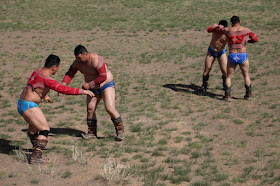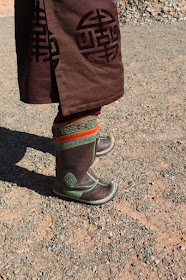The valley of Ulan Bator from the 757
The amount of construction going on in this city is nothing less than astounding! I did not recognize the place from my previous visit in 2006. A flood of Chinese, Russian and Japanese money is investing heavily in the metals industry here, mostly gold production.
On our charter flight to to the Gobi
We landed in the capital of the southernmost province, Dalanzadgad and then it was an hour on the seven lane highway into the camp.
Most of these have en suite bathrooms with showers, two beds, a writing desk and new this year, electricity generated by solar power.
A view of Three Camel Lodge from the basalt lava flow nearby
An inside view of ger #2
First up was a wrestling match. This is the most popular sport in Mongolia, a country that always does well in the Olympic events.
There were four wrestlers and there are no weight or height limits, a tradition dating to times when you could not choose your opponent. There are few other rules.
There was also an incredible archery exhibition with women, who shoot from 50 meters out, and men who shoot from 100 meters.
A young one week colt was held out from the herd so as not to get hurt
Mongolians learn to ride quite young in the Gobi. These boys were 8 years old.
Roping was one of the activities we watched
Then they had a competition to pick up the herding stick while on a gallop
Coming in for the pick up...
...and success!
We had lovely weather. The elevation at the camp is about 5,000 feet so it was not hot and the clouds were spectacular. The Lodge received snow just 12 days before our visit, a unique event for June.
There are nearby petroglyphs on the basalt rocks
This horse was very well rendered with the eye provided by a vesicle (gas pocket) in the basalt rock
Time to head out and explore the area around the lodge. The area is arid but perhaps at the edge of being called a desert
These are the Flaming Cliffs, a sandstone outcrop that is Cretaceous in age and interpreted as desert dune deposits. They are dated at about 80 million years old.
The unit is about 200 feet thick and is weakly cemented. One could loosen sand grains with the palm of their hand.
A series of calcareous beds suggest that the water table was close to the surface of the dune area. The reason this unit is so well known for such a remote area is because of the dinosaur fauna that has been found here.
And we did find bones at the foot of the cliffs.
This seemed to me to be some kind of a long-bone from a dinosaur
The site was first described and made famous by the Central Asiatic Expeditions in the 1920's, led by Roy Chapman Andrews of the American Museum of Natural History. These expeditions were widely reported on in the United States and are what brought the word "Mongolia" into the American lexicon. The expedition was undertaken to find evidence for early man, but of course, this could not be found in Asia. Instead, they discovered the world's first dinosaur egg nest, shown here in this photo from the Flaming Cliffs. I used this image in my second lecture while flying into Mongolia.
Driving around the area, we saw a nomadic family setting up their ger
These can usually be assembled and disassembled within a matter of hours. In fact, when I drove by the next day, this one looked like it had been lived in for months.
A local vendor who drove his motorcycle 10 miles to sell felt items to members of our group. He was quite cooperative in having his picture taken.
Traditional Mongolian boots
A sandstorm blew up from the dunes located about 50 miles west of Three Camel Lodge
The Gobi is a very special place and one I am privileged to have visited. Next stop, Siberia!





































No comments:
Post a Comment
If your comment will not post, email me with the problem.